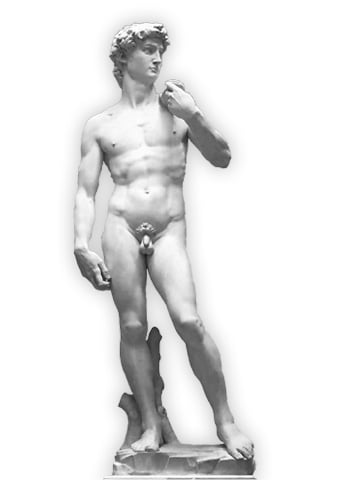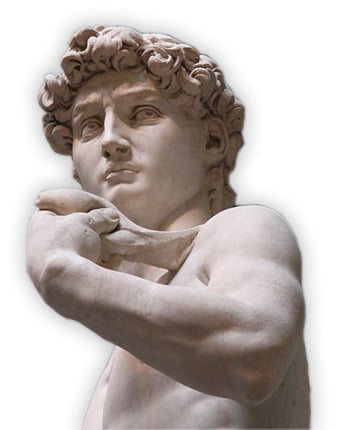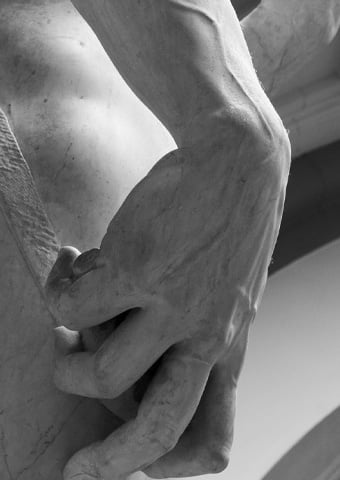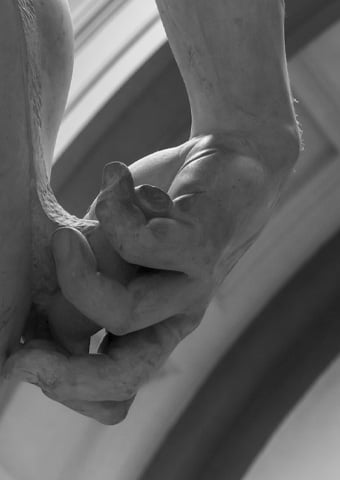Michelangelo’s David
Michelangelo’s David: the timeless synthesis between art and beauty
During the passing of times, art has continually changed its face and, consequently, its purpose: sometimes, it becomes the best method to depict our everyday reality or to create a new one, modeled by the rules of fantasy and pastoral images that our human brains can come up with. However, art has always had one big recurring pattern that never changed through history but only renovated itself: the portrayal of beauty ideals.
In fact, beauty standards have always relied on art and vice versa; art has always relied on the beauty standards themselves. Throughout the centuries, we can see the ideal beauty standards that have modeled our society slowly changing just by looking at the artworks in the museum, perfectly depicted like in a photograph.
However, with their imposing majesty, they almost take the viewers on a new incredible journey through the ideal world because of their perfection. Michelangelo’s David is one of the most imposing and wonderful examples of such timeless beauty and splendor.
Michelangelo’s David: description and main history

The ‘Michelangelo’s David’ is one of the most renowned and wonderful masterpieces in the Renaissance and, most generally, in Italian art history. It is a marble sculpture made by the Italian painter, sculptor, and artist Michelangelo Buonarroti. It was sculpted approximately around the beginning of the Renaissance, between 1501 and 1504. The artwork is 5.17 meters (17 feet) of pure majesty, representing the biblical figure of David, and it is currently exposed at the Galleria of the Accademia in Florence. However, its history is much more complex and fascinating.
In fact, the statue was originally part of a bigger complex of artworks that supposedly depicted some prophets. It was planned to expose the series along the roofline of the east end of the Florence Cathedral. The managers of the Opera del Duomo and the leaders of the Union of the Knitters in Florence wanted to initiate this project to complete and magnify the huge Cathedral.
However, when the statue was completed, the committee in charge of the Cathedral’s building recognized quickly that the statue was by far too big and heavy to be placed on the roof of the imposing architecture. Therefore, they decided to gather 30 of the most important Florentine citizens, along with some of the most influential artists of the time, such as Leonardo da Vinci e Sandro Botticelli, to decide the proper location for the statue.
Many different options arose, but the final decision placed David’s statue in one of the most valuable locations in the whole city: in Piazza della Signoria, next to the entrance of Palazzo Vecchio, the heart of the city and the seat of its civic government. The artwork replaced another masterpiece, a bronze sculpture of Judith and Holofernes by Donatello, and quickly entered the citizens’ hearts.
The artwork, in fact, soon became the symbol of the city itself, representing the defense of civil liberties of the Republic of Florence, at the time one of the few independent city-states. However, in the 19th century, the David was removed from Piazza della Signoria to preserve it from external damages and was exchanged with a copy. The actual statue, made by Michelangelo, was placed in its current home, the Galleria dell’Accademia, where it is still displayed and can be admired by the public in all its splendor.
The Galleria dell’Accademia: the home of Michelangelo’s David
The Galleria dell’Accademia in Florence is one of the most renowned and important art museums in Italy, and it is majorly known for displaying Michelangelo’s David. However, it has a vast and wonderful collection of artworks dated between the 1300s and the 1600s, including many other sculptures by Michelangelo and other Florentine artists, to celebrate the city’s excellent mastery and talent offered in the art field.
The building of the Accademia is located near the Accademia di Belle Arti of Florence, and, although it is far smaller and more specialized than other Florentine museums, it still represents one of the most significant meeting points for visitors and art connoisseurs all over the world. In fact, in 2016, the Galleria dell’Accademia recorded more than 1.46 million visitors, a number that has been surpassed only by the Uffizi Museum.
The Galleria dell’Accademia was founded in 1784 by one of the most eminent men of Florence, Pietro Leopoldo, Grand Duke of Tuscany, and since then, it has become a symbol of culture and pride for the whole city. The Museum was initially created as a location solely dedicated to Michelangelo and its artworks to celebrate the fourth centenary of the artist’s death. However, later it has grown into a more significant project by displaying other artists’ artworks and paintings, housing names such as Paolo Uccello, Sandro Botticelli, Andrea del Sarto, and Domenico Ghirlandaio.

Michelangelo’s David: the history behind a stone block
As mentioned before, the imposing statue, which we all learned to love and cherish because of its beauty, at first was conceived as one of a series of artworks destined to be located on the rooftop of the Cathedral of Florence. But the origins of this creation lie far earlier than its actual birth.
Its story begins with a simple stone block of marble that has been shipped by boat to Florence from the Fantiscritti quarry in Carrara. Artists have known this place from any side of the world because it provides some of the finest and most cherished marble in the whole of Italy and has been used to produce the most beautiful artworks of the Renaissance.
However, this stone block of marble has been stored for many years, unused, while earning peculiar fame. In fact, this stone block was known in the Florentine art world, and it was called unanimously ‘the giant .’This unusual nickname was coined in 1460, when some artists, such as Agostino Duccio and Antonio Rossellino, tried to use it for some of their ideas but were unable to sculpt it, calling it to defeat.
Because of its sturdiness and this unsuccessful project, the stone block has been stored in its warehouse, waiting to be used again. Years later, in the 16th century, the project about the statues for the Cathedral was resumed and the Committee was deciding on the rightful artist to take on such a large-scale and important project.
Many names arose, such as Andrea Sansovino, Leonardo da Vinci and Michelangelo Buonarroti himself. In the end, the latter was named as the rightful master of the project. As soon as Michelangelo came into contact with the colossal and wonderful stone block, he was intrigued by the fine quality of the material, so much so that the artist decided to isolate and dedicate body and soul to its newest project. From the struggles and the astounding genius of this artist, there was born one of the most beautiful and acclaimed artworks of the world: the David.



Characteristics and historical meaning: why David is so acclaimed
Michelangelo’s David represents a wonderful example of a mix between traditional patterns and new, exciting innovations. The biblical David is a traditional image of the pictorial art heritage, especially in Florence. However, while starting his project about David, Michelangelo decided to break the ties with the traditional canons and represent this famous figure in a new way. In fact, according to traditions, David must be represented during his most important achievement: killing Golia ( Goliath ) with its severed head. The artist, instead, decided to portray him the minute before the battle in a very natural standing position.
Michelangelo’s David‘s figure has been portrayed after a meticulous study of the human body, which is evident by the precision in the muscles and look’s details, giving a great image of strength and human power. However, it is noticeable that the head and the hands are slightly more significant than the rest of the body. Still, it has been the author’s choice with an actual meaning: the mind represents the mind, the most precious possession of humankind, while the hands represent the tool that allows humans to make their thoughts into reality.
Therefore, David is not an outstanding representation of beauty standards and perfection; it is also a metaphor for strength, mind, and body. For Florentine citizens, it also represents the victory of the Republic and people’s freedom against the opposing forces of other cities’ kingdoms or nobiliary families, such as the de Medici family.
This is only a short description of this beautiful statue’s many virtues and secrets. Despite the passing of time, Michelangelo’s David still stands tall, looking at the public with its mysterious and intense look and allowing us to admire it in its full glory and beauty.




